Text
Chapter 24: Nerds on the North Bridge
Welcome back to my Totally Lit Road Trip blog, where the lit stands for literary!
Jess and I ended our long weekend in Concord, MA with a visit to the North Bridge, the site of “the shot heard round the world” and the beginning of the American Revolution.

The path to the bridge begins with a quote from Ralph Waldo Emerson:

At the foot of the bridge is a monument that was erected in 1886 to commemorate the “first forcible resistance to British aggression” on April 19, 1775.


There is also a plaque marking the grave of the British soldiers who were killed that day.
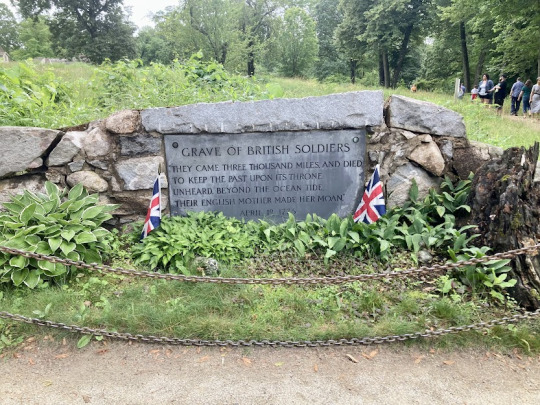
Once you cross over the bridge, you’re greeted by the Minute Man statue, created by Daniel Chester French, whose first art instructor was May Alcott.


From the bridge, could take a short stroll to a visitor center, or take the path to the Old Manse. You could even rent a kayak if you wanted, and paddle your way under the North Bridge.
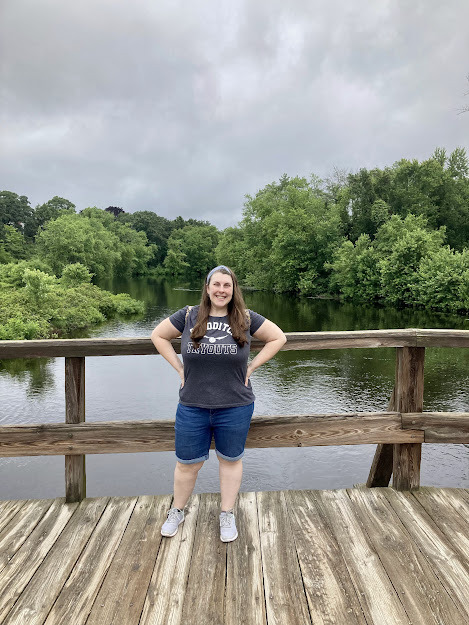
After our visit to the North Bridge, Jess and I stopped for lunch at Jake & Joe’s, where I had a baked mac ‘n cheese casserole that was creamy and gooey and delicious. Then we started our drive back home to NJ.

Here’s our final thoughts about our trip:
Jess
Favorite literary activity: Touring the Old Manse; all the drawings in May Alcott’s bedroom
Favorite non-literary activity: Visiting the Concord museum and seeing Paul Revere’s lantern
Favorite snack/lunch: Crepes from Cafe Zoey
Favorite dinner: Burgers at Copper House
Theresa
Favorite literary activity: Touring the Orchard House and learning more about the Alcott family
Favorite non-literary activity: Visiting the Concord museum and seeing the 150 Years of Art exhibit
Favorite snack/lunch: Mac ‘n Cheese from Jake & Joe’s
Favorite dinner: Sushi at Karma
I hope you enjoyed reading about our literary adventures in Concord! Stay tuned for more literary excursions this summer!
<3 Theresa
P.S. If you’d like to subscribe to email updates from Totally Lit Road Trip blog, fill out this Google Form.
#totally lit road trip#totally lit road trips#totallylitroadtrip#totallylitroadtrips#concord#massachusetts#oldnorthbridge#northbridge
0 notes
Text
Chapter 23: Revolutions on a Rainy Day
Welcome back to my Totally Lit Road Trip blog, where the lit stands for literary!
Today was our second full day in Concord, MA, and despite the steadily increasing rain, we managed to pack in a ton of literary sightseeing.
Our first stop was The Old Manse, a residence where both Ralph Waldo Emerson (who preferred to go by Waldo) and Nathanial Hawthorne lived at some point in their lives. Our tour guide was so knowledgeable and since it was just me and Jess on this tour, it was like having a private guide all to ourselves again.
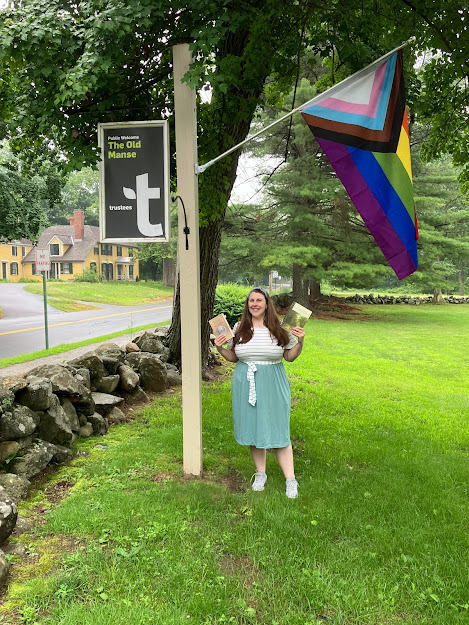
The first thing our guide stressed was that historians see The Old Manse as the birthplace of two different revolutions - The American Revolution, and the Cultural Revolution of Transcendentalism. The home was built in 1769 by Rev. William Emerson (Waldo’s grandfather), who was the minister of Concord. He married the former minister’s daughter, Phebe Bliss. Known as the “Patriot Preacher,” Rev. Emerson was heavily into politics and supported the revolution, making him very popular with his congregation.
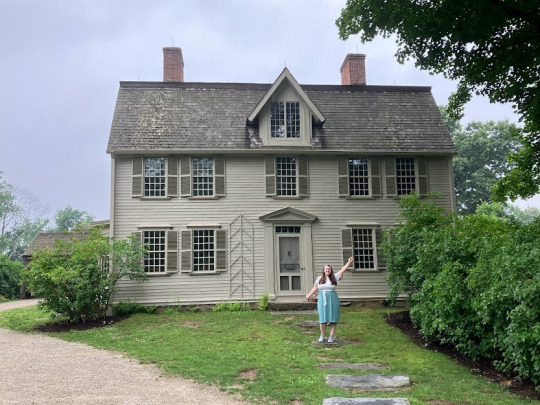
From the window of one of the upstairs bedrooms that would later become Waldo’s bedroom/study, Phebe Emerson and her five children, one of whom would become Waldo’s father, could see the literal beginning of the American Revolution - the first shots fired at the North Bridge. Years later, Waldo would coin the term “the shot heard round the world” in his 1837 poem “Concord Hymn,” which commemorated the Battles of Lexington and Concord.
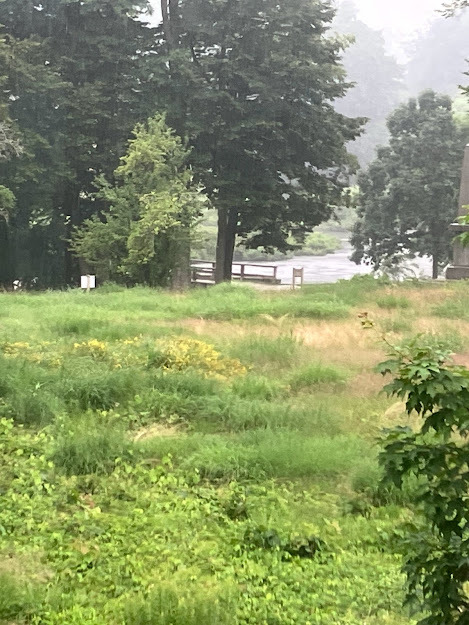
Like his father and grandfather before him, Waldo’s first career path was that of a preacher, however, after the death of his first wife Ellen after only 18 months of marriage, Waldo felt he no longer had the calling of being a minister. Instead, he traveled around Europe for almost a year, meeting other leading authors of the time period, and beginning to shape his philosophies. From this point on, most of his income came from writing and speaking engagements.
After the death of his grandfather, Waldo’s grandmother Phebe remarried, and it was years later when Waldo moved back to the house as an adult to care for his aging step-grandfather. During this time, he wrote “Nature,” the speech considered to be a founding text of the Transcendentalism movement.
Waldo was actually the person who suggested that Nathanial Hawthorne and his wife Sophia be taken on as renters of the home, and Hawthorne is the one who gave it the name “Old Manse”, manse being the British term for a minister’s home. Hawthorne and his wife, Sophia, lived there for about three years, during which he wrote the stories that would eventually come together to form his first successful book, Mosses from an Old Manse. He insisted on writing in the same room of the house which Waldo used as his study, although he had his desk face the wall because unlike Waldo, Hawthorne found nature to be distracting rather than inspiring. Sophia, and accomplished artist, spent much of her time in the house painting. Unfortunately, her last portrait, which she considered to be her best, is of whereabouts unknown.
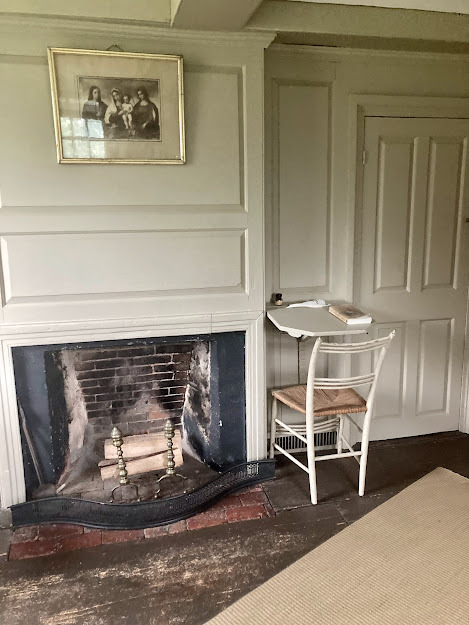
The Hawthornes were eventually evicted because they were unable to continue paying their rent, due to a dry spell of both writing and artistic income. But they left their lasting marks on the home: Sophia engraved window panes with her diamond ring, and Nathanial left a hole in the house where he installed a stove in the kitchen. (He took the stove with them when they moved out.)

After this the Hawthornes moved to Salem, MA, where Nathanial would go on to write House of the Seven Gables and The Scarlet Letter, arguably his most famous work of fiction. They later moved back to Concord and lived at The Wayside, which is unfortunately not currently open to the public.
One of my favorite things in the house was a Steinway square grand piano, which is still in playable condition. In fact, the tour guides actually encourage guests to sit down and play a few chords to keep it in good working order! Obviously, I had to give it a go, and I can now say that I’ve played a square grand.
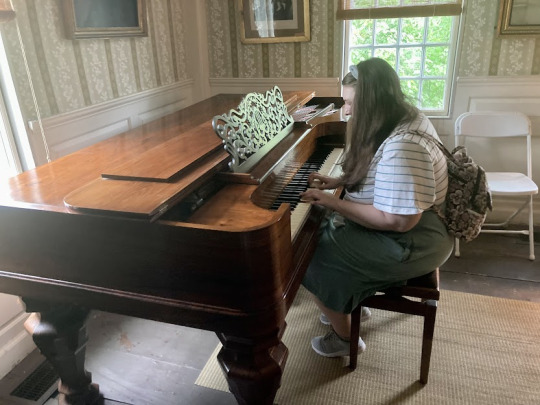
Another cool artifact in the house is a grandfather clock built in Limerick, Ireland, which still keeps accurate time when wound, and which stands in the original position in the house that it has occupied since Waldo’s grandfather purchased it.
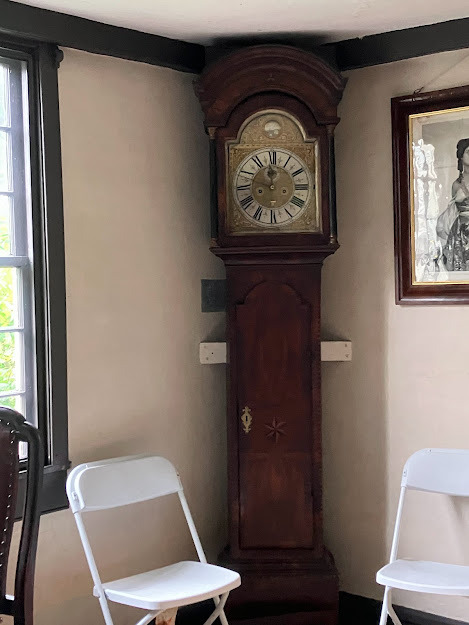
The bookcases in the house are all built horizontally, and stacked on top of each other, unlike today’s bookshelves. Our tour guide told us that this is because the Emerson’s highly valued their tomes and wanted to be able to easily lift and slide the bookshelves out the windows in case of a fire.

And finally, I would be remiss if I failed to mention Longfellow, the preserved owl that resides at The Old Manse. Apparently no one know how he came to be in the house, but Nathanial Hawthorne found him in the attic when he moved in. The owl is believed to be from colonial times, meaning it existed before the house was built. Nathanial loved it and wanted it to be a centerpiece for conversation when guests came over, but Sophia was creeped out by it, leading to an unending “game” where she would hide it back up in the attic, and he would bring it down again and put it in a different room of the house.

After our wonderful tour of The Old Manse, we stopped for a quick bit to eat at Main Streets Café, where I had a mac ‘n cheese grilled cheese sandwich. That’s right folks, deep fried mac ‘n cheese wedges on a sandwich with even more delicious, cheesy gooiness. Highly recommend.

With our bellies full, we headed over to Emerson House, the home Emerson lived in with his second wife and four children. Emerson House is massive! There are so many rooms and split-levels and doors that lead who knows where. You could get lost in there without a tour guide, but luckily we had a team of lovely women to lead us through the house both physically and historically.
Unfortunately, you can’t take pictures inside Emerson House, but here’s me standing out front in the rain.
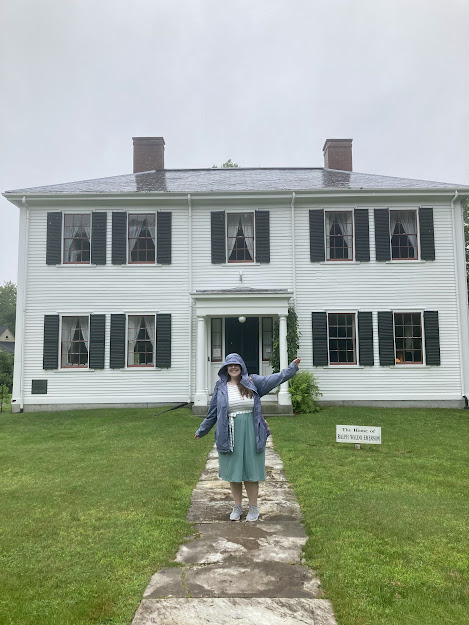
One of the coolest things about Emerson house is that, unlike the other authors’ homes in the areas which are all owned by trusts or preservation societies, Emerson House is still owned by direct descendants of Waldo. They take care of the upkeep and allow the Ralph Waldo Emerson Memorial Association to give tours.
Here are some interesting facts we learned about Emerson and his home, in no particular order:
In July 1872, a fire broke out in the attic of the home. Luckily, no one was injured, and they even managed to get all of the furniture (and more importantly, all of the books!) out in time. (Possible due to easily yeet-able bookshelves?) Due to smoke and water damage, the house was unlivable for a time. Emerson did have the house insured, but the whole town banded together to raise additional funds for restoring the home. Different neighbors also volunteered to keep the family’s belongings safe until the home was livable again. While the house was being reconstructed, Emerson and his daughter traveled to Europe and Egypt, and when they returned, the town had a celebration in their honor, and even closed schools for the day!
Waldo was at least six feet tall, and as such would have to duck in some of the lower hallways of the home. He hung his gardening hat on a peg which only he was tall enough to reach.
The Emersons entertained visitors from all over, and Waldo almost never turned away guests, even unannounced ones. He was very generous if people asked for money, and never let anyone leave without a meal.
As a friend of Waldo, Henry David Thoreau lived in the house for long spans of time on multiple occasions. He typically stayed in the room that was meant to be for Waldo’s brother Charles, who tragically died before his wedding. It took Waldo 10 years to finish the room and eventually make it the master bedroom, but Thoreau stayed there frequently. He was a fan favorite of Emerson’s four children, who could often see him approaching the carriage entrance from their window in the nursery. They loved him because he made good popcorn and told good stories.
Waldo was a great friend to the Alcott family. He allowed Louisa May Alcott to use his library and often gave her book recommendations. Alcott’s first book, Flower Fables, is dedicated to Waldo’s daughter, Ellen. Waldo also lent many pieces of art to Louisa’s sister, the artist May Alcott, including one piece that was a wedding gift! She would make copies of the paintings, a common practice for aspiring artists at the time.
And finally, every single room in Emerson House has at least one bookshelf. That right there is life goals.
Right across the street from Emerson House is the Concord Museum, so that was our next stop. This museum has many interactive exhibits and mainly focuses on Concord’s Revolutionary War history, although it does also have a fair share of local author and artist history, as well.
One of the first things you encounter in the museum’s foyer is a replica of Thoreau’s writing desk, which you can sit at and write in a little notebook there.
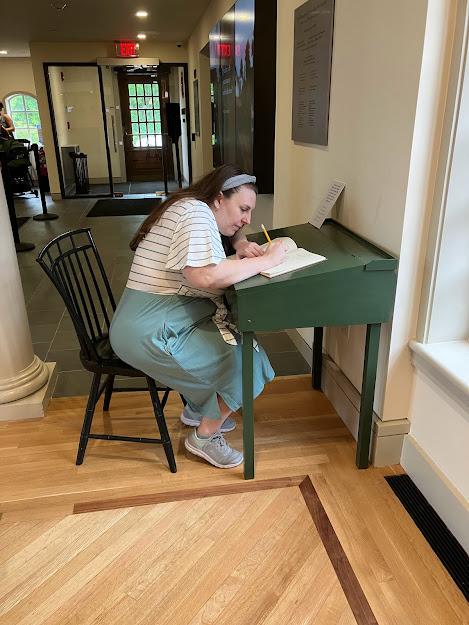
The original green desk is in one of the galleries as you walk through.

The museum also has many odds and ends from the different local authors. One is Emerson’s writing desk, which was originally green, but then he later painted it black. The replica that resides at The Old Manse is green.

One of Louisa May Alcott’s tea kettles, which she brought with her when she served as a Civil War nurse, is also at the museum.

Also on display is the entirety of Emerson’s study, displayed exactly as they were in his lifetime. Everything in the room is the original!

Finally, there is a room dedicated to Thoreau’s belongings, including his bed frame, a wooden flute, and some pencils and surveying tools.

A large portion of the Concord population were abolitionists, and although she was not a native of Concord, the museum does have a first edition of Harriet Beecher Stowe’s Uncle Tom’s Cabin, which was originally published in two volumes.

We were lucky enough to be visiting during the Concord Free Public Library’s 150 Years of Art Celebration, so there was a special exhibit with art pieces that are usually at the library. This included busts of Hawthorne, Thoreau, and Alcott, as well as one of May Alcott’s paintings. The largest piece in the library’s collection is a portrait of Emerson, with a rainbow in the background.



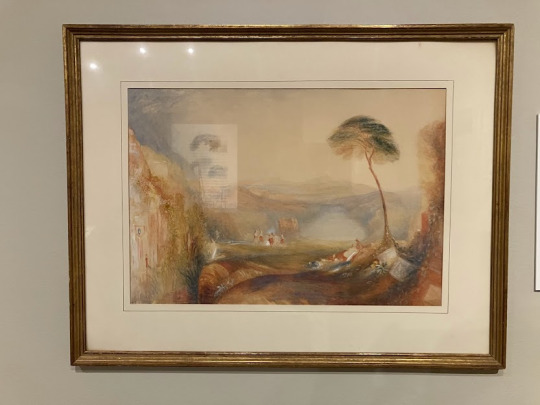

After leaving the museum, we browsed for a bit at Concord Bookshop and then drove over to Walden Pond once it finally stopped raining. There, we were able to visit the replica of Thoreau’s writing cabin, which is very small! The original cabin was located on the other side of the pond, but is no longer standing. Visitors who are into hiking can hike up to the point where the cabin once stood and where many admirers leave rocks as a sign that they’ve been there. (Not me and Jessica. We’re indoor people!)



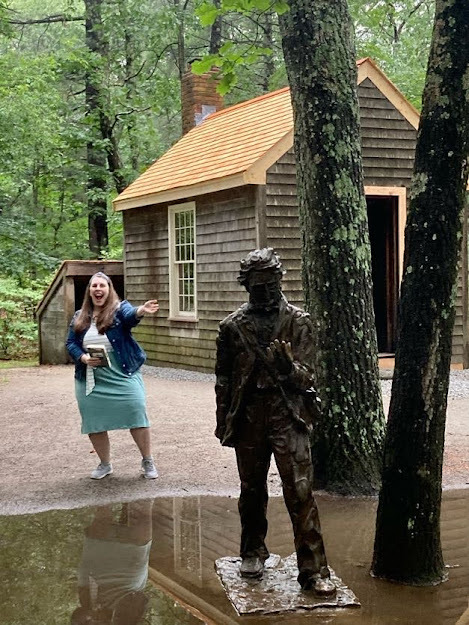
We ended our night with some sushi at Karma (highly recommend the Golden Banana Roll...banana and eel, who knew?!), and ice cream at Bedford Farms, where their “small” is my “large”.

In two and a half days, we managed to squeeze in every literary and historical attraction that we planned for, which is pretty impressive, especially considering the rain. It was definitely made easier by the fact that everything in Concord is so close to each other.
Before we head home tomorrow, we hope to stop by the North Bridge, the site of the beginning of the American Revolution. Hopefully the rain will hold up long enough to let us walk to the bridge and see Daniel Chester French’s Minute Man statue.
Stay tuned for more literary/historical adventures!
<3 Theresa
#totallylitroadtrips#totally lit road trips#totallylitroadtrip#totally lit road trip#concord#massachusetts#the old manse#emerson house#concord museum#ralph waldo emerson#nathaniel hawthorne#louisa may alcott#henry david thoreau#walden pond
0 notes
Text
Chapter 22: Farm & Orchard
Welcome back to my Totally Lit Road Trip blog, where the lit stands for literary!
Today’s adventures took us all around Concord, MA, as we learned about Henry David Thoreau and Louisa May Alcott, as well their relationships with each other and other authors in the area. I think it says a lot about the authors that despite age and gender differences, they inspired each other’s writing and played a role in each other’s lives.

Jess and I started our morning at Thoreau Farm, where we were treated to a private tour, because we were the only ones there. Our tour guide, Barbara, is an amazing historian who told us the saga of the Thoreau family’s life on this farm. Even though Henry David Thoreau only lived there for eight months after he was born, the farm played a large role in his writing due to the stories his mother told him about the place. His grandmother, Mary Jones, was living in the house with her husband, and when he died, the “widow’s third” rule went into effect, meaning that even though she couldn’t own the house, she could legally continue living in 1/3 of it. Mary “swapped” homes with her daughter Cynthia (Thoreau’s mother), since she was younger and would have an easier time farming the land to make a profit. This is how Thoreau came to be born on a farm not technically owned by anyone in his family.

In 1995, when the last living owner of the house passed away, developers wanted to purchase the land and build condos. This prompted a group of historians and literature lovers to create a trust and raise the nearly $1M needed to purchase the land and restore the house. Rather than restoring it to its original form, as a lot of historical societies do with old houses, the trust wanted to refurbish in a way that would honor Thoreau’s memory and lifestyle. Given that he was a huge proponent of finding harmony in nature, the house was refurbished using recycled material and environmentally friendly paint, and uses solar panels to provide most of its electricity.
One interesting tidbit about the house is that its original foundation was about 300 yards away from where it lies now, and no one really knows why it was moved. It certainly would have been easier to just build a new house on the place where it is now, and historians have not discovered a reason for its move.
Inside the house you can see most of the original floorboards and walls, which were repainted to match the original colors in the house, although they left a few spots un-painted for comparison.

On our tour, Barbara told us about Thoreau and his siblings. He and his brother John both (unsuccessfully) proposed to the same woman. A few weeks later, John cut himself shaving and ultimately died of lockjaw. Thoreau was so distraught over the death of this brother that he wound up developing what we now know were psychosomatic symptoms which mirrored John’s so strongly that his family was convinced Thoreau must have cut himself as well. He eventually recovered, and went on to write A Week on the Concord and Merrimack Rivers, about a boat trip he took with John before his passing.
Thoreau’s younger sister Sophia (pronounced So-Fye-Uh) was an accomplished artist, and drew the cover art used for Walden, the book for which Thoreau is probably most well-known. Additionally, the family were abolitionists, and his older sister, Helen, founded the first woman’s abolitionist group.

Thoreau Farm is also still a fully functional farm, and volunteers from a non-profit organization called Gaining Ground farm the land and donate all the produce to local food pantries and meal programs. We took a few minutes to stroll around their crops, and it was really impressive.
My favorite new plant discovery came in the form of Egyptian Walking Onions, which were growing in one of the small garden plots near the house. When I said I wondered how they tasted, Barbara gave us permission to pick a few, if we would try them and let her know what they tasted like. Can confirm they tasted like red onions, just in miniature form! The Egyptian Walking Onions are an heirloom plant, meaning the seeds were from Thoreau’s time period.

(The little purple buds in the phot above are actually the Egyptian Walking Onions! They’re very small, but very tasty!)
After a quick and delicious lunch at Nashoba Brook Bakery, we headed over to Orchard House, the family home of Louisa May Alcott.

As you approach the house, the first thing that stands out is the lovely little garden out front, which is planted with the same plants and flowers that each of the four March sisters plants in her own little garden plot in Little Women. The plots are labeled accordingly with the sisters’ names - Meg, Jo, Beth, and Amy.

The first part of the tour takes place in the Concord School of Philosophy building, which Alcott’s father built in 1879. He was a Transcendentalist, who believed in education reformation. He believed in things like recess and field trips, and opposed corporal punishment, which was widely used at the time.
In the Concord School of Philosophy, you’ll find benches that were created for the schoolhouse scenes in the 2019 Little Woman film, and donated to Orchard House after filming. You can sit on them as you view a short documentary about Orchard House, narrated by a very compelling “Louisa May Alcott”, played by Jan Turnquist. You can watch the documentary here, if you are a member of Thirteen PBS.
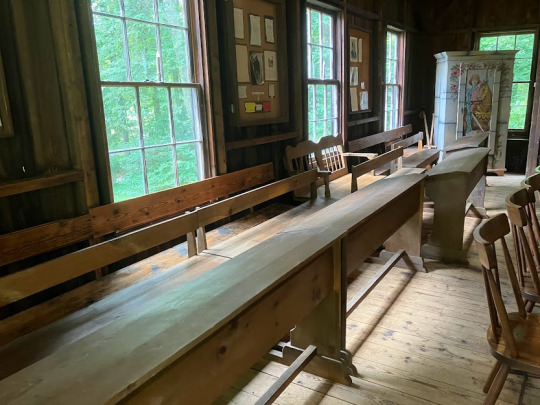
After viewing the documentary, it was time to tour the house. Unfortunately, photography is not allowed, so if you want to see the residence in all its glory and fine detail, you’ve got to come visit for yourself.

We learned that the family bought Orchard House when Louisa was 25 years old. Prior to that, the family had lived in 29 houses over a span of 30 years, which sounds exhausting. After purchasing the house, which was only a few rooms, Alcott’s father had a nearby tenant house rolled in using logs, and attached it to the main house, making the whole residence much more spacious for his family. Louisa and her sisters helped with painting and setting up the house, although her sister Beth died before the family officially moved in. Beth’s melodium (a reed organ that resembles a small keyboard) and her portrait reside in one of the sitting rooms.
Due to the success of Alcott’s writing, she was able to furnish the family home with a lot of nice things, many of which are still present in the house today. She was also able to finance her youngest sister May’s art lessons in Europe, which were necessary because in America, art was not seen as a viable career for a woman. May had a small studio room in Orchard House where she gave art lessons, and one of her students, Daniel Chester French, eventually went on to design the Lincoln Memorial.
May spent many years in Europe learning art from the masters, eventually marrying and having a daughter, whom she named after her sister Louisa. Unfortunately, May passed a way shortly after giving birth, and then Lulu was sent back to America to be raised by Louisa for about nine years. Lulu eventually moved to Switzerland, where she lived until her death in 1975 at the age of 95.
May’s artwork lives on, however, as it can be found in every room in the house. From sketches to paintings to ink drawings all over the windowsills and walls, May’s art gives visitors glimpses into the lives of the Alcotts and the art styles of the time period. Due to a current art exhibit with the Concord Library, more of May’s art was on display than usual, including a silk dress which she hand painted. In addition, the wedding dress of the eldest sister, Anna, was also on special display in Louisa’s bedroom. The silvery gray silk was certainly unlike any modern wedding dress you’d see today, but it had a very sophisticated look nonetheless.
Some other items of note in the house were Louisa’s boots and writing desk. The boots are kept in a costume trunk from when the sisters and their friends would put on plays. The very same boots are mentioned in Little Women as belonging to Jo, who wears them to play Roderigo, the same role Louisa wore the boots for in real life. Louisa’s writing desk, though small in size, was large in what it represented - her family’s faith in her writing ability. During her lifetime, it was unfitting for a woman to have her own writing desk, as writing wasn’t seen as an appropriate career for them, similar to art. Louisa’s father build the desk for her, showing how strongly he believed in her.
Something I already knew before visiting Orchard House, but that I still think is interesting and important to mention is that when Alcott was writing Little Women, she fully intended for Jo, the character modeled after herself, to remain a “spinster,” just as Alcott was. However, her publisher absolutely forbid that, so as a “compromise,” Alcott created a sort of unexpected character for Jo to marry, rather than the fan favorite pick, Laurie.
One thing I didn’t know before our tour was how involved the Concord authors were in each other’s lives. Nathanial Hawthorne lived next door to the Alcotts, and Thoreau and Emerson were contemporaries of Louisa’s father, Amos Bronson. They even joined the family for Anna’s wedding.
After our tour of Orchard House, Jess and I explored downtown Concord a bit, and visited a few antique stores, a chocolate shop, and a cheese shop. Then we went back to our hotel to unwind for a bit before heading to Copper House Tavern for dinner. We both had fancy burgers that were quite scrumptious, and very satisfying. Now we’re back at the hotel resting up for tomorrow. We’ve got a lot planned, and it looks like rain all day, but luckily most of our adventuring will take place in doors.
Tune in tomorrow for some more literary adventures in Concord!
<3 Theresa
#totally lit road trip#totallylitroadtrip#concord#henry david thoreau#louisa may alcott#massachusetts#totallylitroadtrips#totally lit road trips#little women#walden
4 notes
·
View notes
Text
Chapter 21: Cemeteries & Crepes
Welcome back to my Totally Lit Road Trip Blog where the lit stands for literary!
After a little snafu with the old hosting site, I’ll be continuing to chronicle my road trip adventures here on Tumblr.
It’s been a minute since my last literary adventure, but now that it’s summer, this teacher is ready for some R & R...Reading & Roaming!
The first literary road trip of the summer brings us to Concord, Massachusetts, with a pit stop in Providence, Rhode Island along the way. Joining me for the first time is my friend & roommate, Jess.
As part of my goal to visit at least one literary destination in each state, Rhode Island proved to be a little tricky. Being the smallest state, there’s not a ton going on here book-wise. However, Rhode Island is known as the home of H.P. Lovecraft, who was a famous horror & “weird fiction” writer. Now, if you know me in real life, you know that horror is my least favorite genre. I simply do not like to be scared and I hate gore, which is what a lot of modern horror entails. But with his sci-fi take on horror, Lovecraft is much more my vibe.
Prior to embarking on this trip, I read three of Lovecraft’s short stories: “The Call of Cthulhu”, “At the Mountains of Madness”, and “The Dunwich Horror”, and I enjoyed being creeped out (but not utterly terrified) by all three. “At the Mountains of Madness” in particular reminded me a lot of Poe’s “The Narrative of A. Gordon Pym,” which Lovecraft actually references in his short story. After my first foray into Lovecraft stories, I’ve reached the conclusion that I do like horror - but just “classics” like Poe, Dracula, and Frankenstein.
Our first stop on this road trip, therefore, was H.P. Lovecraft’s grave at Swan Point Cemetery in Providence, RI. (Okay, it was actually our second stop. After five hours in the car, we needed food first, so we stopped for some delicious crepes at Café Zoey. We recommend the Notre Jam, Elvis in Providence, & Campania crepes!)
Unlike the two cemeteries I visited on last year’s road trips, this one was easy to locate and navigate. Third time’s the charm, I guess! One of the things I love about visiting authors’ graves is seeing all the little trinkets that fans leave on the stones. Lovecraft’s grave had the usual suspects like rocks and pens, but it also had tons of coins, and even two bags of Trolli candies (the octopus and crawler varieties, naturally).

After paying our respects to Mr. Lovecraft, we hopped back in the car and headed to Concord, MA, where we’ll be for the majority of our trip. There are a TON of literary attractions in Concord, because it was home to so many famous authors, including Louisa May Alcott (Little Women), Nathaniel Hawthorne (The Scarlet Letter), and Ralph Waldo Emerson and Henry David Thoreau (both essayists & poets).
We decided to stick with the theme of graveyards today, so after we checked into our hotel, we headed to Sleepy Hollow Cemetery, where you can find the final resting place of all four of these writers on the appropriately named Author’s Ridge.

Despite the fact that we had a mobile map of the cemetery, it still took us a few minutes to figure out exactly how to find Author’s Ridge, but eventually we figured it out. The authors are all buried on family plots, and it’s interesting to see the different ways that each family marked their gravestones. For example, the Alcott family has a large monument with the last name on it, and small gravestones with each family members’ initials, whereas the Thoreau family used first names on their smaller gravestones.
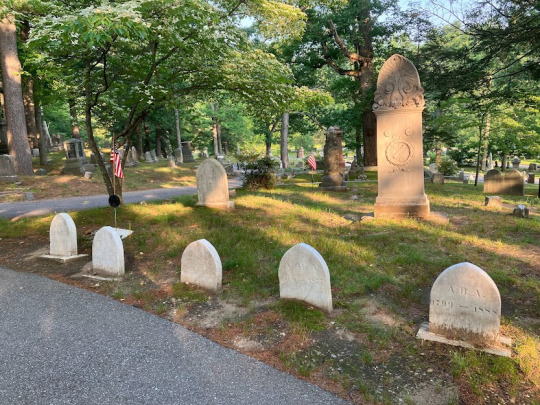
(The Alcott family plot.)




After our visit to Sleepy Hollow Cemetery, we ended our night with dinner at Concord’s Colonial Inn, where Jess had a steak, and I enjoyed some great ravioli in pesto cream sauce.
Over the next few days, we’re going to visit museums and authors’ homes, so check back soon for more updates!
<3 Theresa
P.S. If you’re new to Totally Lit Road Trips, you should definitely check out my previous blog posts here.
#totallylitroadtrip#louisa may alcott#ralph waldo emerson#henry david thoreau#nathaniel hawthorne#h.p. lovecraft#author's ridge#sleepy hollow#massachusetts
0 notes
Text
Welcome to my new road trip blog!
Hey everyone! If you’ve been following my road trip adventures over the last year, then you know I used to host my blog on Wix.com. Unfortunately, I’ve reached the media capacity for a free account and since this is just a personal blog, I want to keep it as low cost as possible. So, here we are on Tumblr!
If you’d still like to receive emails whenever I update the road trip blog, you can fill out this Google Form.
My blog posts about my previous literary road trips will remain available at Wix.
1 note
·
View note